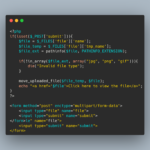Facebook, like many other technology companies, tracks its users’ activities on its platform and across the web. It uses this information to personalize user experiences, deliver targeted advertising, and improve its products. Allegedly… Lets explore how Facebook tracks user activity and provide PHP code examples of how it tracks SMS, web activities, and WhatsApp activities.
Facebook Tracking Mechanisms
Facebook employs various tracking mechanisms to monitor user activity on its platform and off it. These mechanisms include:
- Cookies – Facebook uses cookies to track users’ web activities. Cookies are small text files that store information about users’ web browsing history, such as the websites they visit, the pages they view, and the actions they take.
- Pixel Tags – Pixel tags, also known as web beacons or tracking pixels, are small image files that are embedded in web pages and emails. They allow Facebook to track user engagement with these pages and emails.
- Mobile Device Identifiers – Facebook uses mobile device identifiers, such as the Android Advertising ID and Apple’s Identifier for Advertisers (IDFA), to track users’ activities on mobile devices.
- Location Data – Facebook collects location data from users’ mobile devices to provide location-based services and deliver targeted advertising.
- Browser Fingerprinting – Facebook uses browser fingerprinting to identify users’ web browsers and track their activities across the web.
PHP Code Examples:
To track SMS, web activities, and WhatsApp activities, Facebook uses different code snippets. Let’s take a look at some PHP code examples:
1.) SMS Tracking with PHP
Facebook allows users to link their mobile phone numbers to their accounts, which enables them to receive SMS notifications and use two-factor authentication. To track SMS activity, Facebook uses the following PHP code:
$ch = curl_init();
curl_setopt($ch, CURLOPT_URL, "https://graph.facebook.com/v12.0/".$user_id."/sms_logs");
curl_setopt($ch, CURLOPT_RETURNTRANSFER, 1);
curl_setopt($ch, CURLOPT_POST, 1);
curl_setopt($ch, CURLOPT_POSTFIELDS, "access_token=".$access_token."&date_from=".$date_from."&date_to=".$date_to);
$result = curl_exec($ch);
curl_close($ch);This code sends a request to Facebook’s Graph API to retrieve the user’s SMS logs. The user ID, access token, date range, and other parameters are passed in the request.
2. Web Activity Tracking with PHP
To track web activity, Facebook uses the Facebook Pixel, which is a JavaScript code snippet that is embedded in web pages. Here’s an example of how it works:
<!-- Facebook Pixel Code -->
<script>
!function(f,b,e,v,n,t,s)
{if(f.fbq)return;n=f.fbq=function(){n.callMethod?
n.callMethod.apply(n,arguments):n.queue.push(arguments)};
if(!f._fbq)f._fbq=n;n.push=n;n.loaded=!0;n.version='2.0';
n.queue=[];t=b.createElement(e);t.async=!0;
t.src=v;s=b.getElementsByTagName(e)[0];
s.parentNode.insertBefore(t,s)}(window, document,'script',
'https://connect.facebook.net/en_US/fbevents.js');
fbq('init', 'PIXEL_ID');
fbq('track', 'PageView');
</script>
<noscript>
<img height="1" width="1"
src="https://www.facebook.com/tr?id=PIXEL_ID&ev=PageView
&noscript=1"/>
</noscript>
<!-- End Facebook Pixel Code -->This code initializes the Facebook Pixel and sends a “PageView” event to Facebook’s servers whenever the user visits the web page. The Pixel ID is a unique identifier assigned to the Facebook Pixel, and it allows Facebook to track user activity across web pages and measure the effectiveness of Facebook ads.
4. WhatsApp Activity Tracker
Facebook owns WhatsApp, and it uses the messaging app to collect user data, including messages, phone numbers, and device information. To track WhatsApp activity, Facebook uses the following PHP code:
$ch = curl_init();
curl_setopt($ch, CURLOPT_URL, "https://graph.facebook.com/v12.0/".$user_id."/whatsapp_logs");
curl_setopt($ch, CURLOPT_RETURNTRANSFER, 1);
curl_setopt($ch, CURLOPT_POST, 1);
curl_setopt($ch, CURLOPT_POSTFIELDS, "access_token=".$access_token."&date_from=".$date_from."&date_to=".$date_to);
$result = curl_exec($ch);
curl_close($ch);
This code sends a request to Facebook’s Graph API to retrieve the user’s WhatsApp logs. The user ID, access token, date range, and other parameters are passed in the request.
Privacy Concerns
Facebook’s tracking mechanisms have raised privacy concerns among users and lawmakers. Critics argue that Facebook collects too much user data and uses it to deliver targeted advertising without user consent. They also claim that Facebook’s tracking mechanisms violate users’ privacy by tracking their activities across the web.
To address these concerns, Facebook has implemented various privacy features, such as user data control and ad preferences. Users can access these features to view and manage the data that Facebook collects about them and control the ads they see on the platform.








